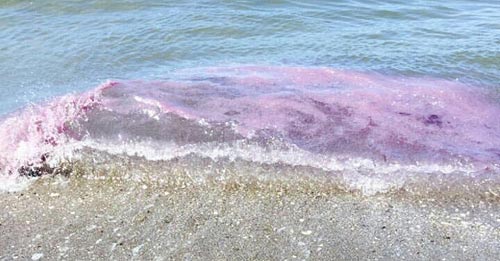Shades of a Canfield Ocean — Hydrogen Sulfide in Oregon’s Purple Waves?
28
August, 2015
Are
we already starting to awaken
some of the horrors of the ancient hothouse ocean?
Are dangerous, sea and land life killing, strains of primordial
hydrogen sulfide producing bacteria starting to show up in the
increasingly warm and oxygen-starved waters of the US West
Coast? This
week’s disturbing new reports of odd-smelling, purple-colored waves
appearing along the Oregon coastline are a sign that it may be
starting to happen.
(Purple
waves wash over the Oregon beach of Neskowin on August 15. A form of
hydrogen sulfide consuming bacteria is known to color water purple.
Is this an indicator that the deadly gas is present in Oregon’s
waters? Image source: Jeanine Sbisa and Beach
Connection.)
A
Dangerous Beauty
Oregon
beachgoers and ocean researchers alike are flummoxed. There’s
something strange in the water. Something that’s coloring the waves
of Oregon’s beaches purple even as the off-shore waters are painted
greenish-blue. These puzzling purple waves have been washing up along
the Oregon Coastline for the better part of a month. And no-one seems
to know exactly what’s causing it.
“The purple was only on the edge of the water. I did not see any patches in the deeper water. ( in fact the deeper water was a beautiful turquoise, instead of the deep blue that it usually is at Winema). Some of the waves were a deep clear purple. Other waves in other segments were a rich foamy lilac color. The colors were amazing. Very beautiful.”
All
up and down Oregon’s coastline similar reports have been surfacing.
Oregon State Park Ranger Dane Osis photo documented another incident
at Fort Stevens State Park near Astoria. And eyewitnesses at some
locations have described a ‘funky smell’ issuing from some of the
purple-colored waters.
Initial
reports have claimed that there’s no evidence the purple waters are
harmful. But such assertions may well be premature.
Purple
Sulfur Bacteria
At
issue is the fact that the waters off Oregon are increasingly warm.
They are increasingly low oxygen or even anoxic. Conditions that are
prime for the production of some of the world’s nastiest ancient
species of microbes. The rotten-eggs smelling hydrogen sulfide
producing varieties. The variety that paint the waters green (or
turquoise as described by Jeanine Sbisa above) or even an ugly black.
And there is one primordial creature in particular that thrives in
warm, low-oxygen, funky-smelling water. An organism that’s well
known for coloring bodies of water purple — the
purple sulfur bacteria.
(Artist’s
rendering of what a Canfield Ocean may have looked like. A Canfield
Ocean is a deadly hothouse ocean state implicated in 5 of 6 major
mass extinction events. And, perhaps, we see a hint of this deadly
ocean along the Oregon coast today. Image source:Biogeochemistry.)
In
order for blooms of purple sulfur bacteria to form, waters have to be
low in oxygen or anoxic. There has to be hydrogen sulfide gas present
in the water. And the water has to be relatively warm. This is
because the bacteria is warmth-loving, anaerobic, and it uses the
sulfur in hydrogen sulfide gas as part of its energy production
process.
In
the current day, the purple sulfur bacteria is present in anoxic
lakes and geothermal vents. But during ancient times and during times
of hothouse extinction, the purple sulfur bacteria are thought to
have thrived in the world’s oceans — painting them the strange
tell-tale purple we see hints of along the Oregon shoreline today. A
purple that was the hallmark color of a life-killing
hothouse ocean.
In
his ground-breaking book “Under
a Green Sky,” Dr.
Peter Ward vividly describes what a Canfield
Ocean may
have looked like:
Finally we look out on the surface of the great sea itself, and as far as the eye can see there is a mirrored flatness, an ocean without whitecaps. Yet that is not the biggest surprise. From shore to the horizon, there is but an unending purple colour– a vast, flat, oily purple, not looking at all like water, not looking anything of our world. No fish break its surface, no birds or any other kind of flying creatures dip down looking for food. The purple colour comes from vast concentrations of floating bacteria, for the oceans of Earth have all become covered with a hundred-foot-thick [30m] veneer of purple and green bacterial soup.
The
purple sulfur reducing bacteria, though not dangerous themselves,
live in a kind of conjoined relationship with the much more deadly
hydrogen sulfide producing bacteria. The purple, is therefore, a
tell-tale of the more deadly bacteria’s presence. And hydrogen
sulfide producing bacteria may well be the most dangerous organism
ever to have existed on the planet — largely responsible for almost
all the great extinction events in Earth’s deep history. For
hydrogen sulfide itself is directly toxic to both land and
ocean-based life. Its deadly effects are increased at higher
temperatures. And not only is it directly toxic in both water and
air, if it enters the upper atmosphere it also destroys the ozone
layer.
(Video shot on July 18 [please excuse the colorful language] showing purple waters and dead jellies, barnacles and mussels on another Pacific Ocean beach. Video source: Gezzart.)
Purple
waters are a sign that the little organisms that produce this deadly
agent may be starting to bloom in an ocean whose health is
increasingly ailing. Tiny tell-tales that we’re on a path toward a
hothouse Canfield Ocean state. A path we really don’t want to
continue along through the ongoing burning of fossil fuels. For that
way leads toward another great dying.
Links:
Under
a Green Sky


No comments:
Post a Comment
Note: only a member of this blog may post a comment.